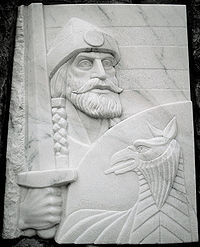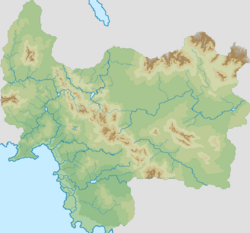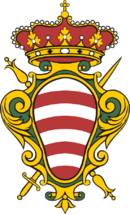Granzery
This article is incomplete because it is pending further input from participants, or it is a work-in-progress by one author. Please comment on this article's talk page to share your input, comments and questions. Note: To contribute to this article, you may need to seek help from the author(s) of this page. |
Granzerian Kingdom Grozyar Királyság (Granzerian Language) | |
|---|---|
Flag
Coat of Arms
| |
| Motto: "Dicsőség és Becsület az szülőhaza!" "Glory and Honour for the Fatherland!" | |
| Anthem: "Grozyarországi Nagymara" official | |
| Location of Granzery (Green) Location of Granzery (Green) | |
| Map of Granzery showing regions Map of Granzery showing regions | |
| Capital and largest city | Veraglia |
| Official languages | Granzerian |
| Recognised national languages | Straknian Karpatian |
| Ethnic groups (2013) | 90.1% Granzerian inc. Strakni and Transkarpatian 4.1% Elesarian 2.0% Kevert Grozyar 3.8% Other |
| Demonym(s) | Granzerian official |
| Government | Federal one-party presidential constitutional monarchy |
• Vezér | István Árpád |
• King | Karoly III |
• Minister-Regent | Szabolcs Černý |
| Legislature | Senate |
| Establishment | |
• Bastarny | 1040BC |
• The First Grozyar Empire | 4th May 1619 (Unification Day) |
• The Grozyar Birodalom | September 6th, 1928 |
• Granzery People's Democratic Republic | January 29th, 1949 |
• Second Granzerian Republic | March 10th, 1971 |
• Kingdom of Granzery | January 12th, 2019 |
| Area | |
• Total | 1,205,776 km2 (465,553 sq mi) |
• Water (%) | 1% |
| Population | |
• 2014 estimate | 95,256,304 |
• Density | 79/km2 (204.6/sq mi) |
| GDP (PPP) | estimate |
• Total | $5.04 trillion |
• Per capita | $52,910 |
| GDP (nominal) | estimate |
• Total | $4.71 trillion |
• Per capita | $49,446 |
| Gini | medium |
| HDI (2014) | very high |
| Currency | Granzery Rucat (GIR) |
| Date format | dd/mm/yyyy (AD) |
| Driving side | right |
| Calling code | +223 |
| ISO 3166 code | GRZ |
| Internet TLD | .grz |
The Granzerian Kingdom (Granzerian: Grozyar Királyság), also known as Granzery, is a Constitutional Monarchy located in Eastern Vesperia. It is ruled by the Senate of the Granzerian Kingdom, for which an election is held every 3 years, and the Vezér of the Granzerian Kingdom, for which elections are not held. Granzery is comprised of seven provinces, the largest of which Bastarnyy, is home to the Second largest city in the nation, Csongrád. Győr-Veraglia is the smallest by land area but second largest by population, and is home to the capital city of Veraglia. The other Provinces are in descending order of population size, Nagykert, Transkarpatia, Téliföld, Jász-Nagykun and Straknia.
Etymology
The name Granzery originates from the not!German word Grenze, which was used by the Sassic kingdoms inhabiting the Granzerian basin prior to the Grozyar migrations of 700AD. It was used to describe Grozyar tribes as "those beyond the borders". The term Bastarny was used frequently to describe the area until the mid 1900s. The term Grozyarország is used natively, although it is sometimes shortened to Grozyar.
History
The Bastarnum Empire 720BC-385AD.
the Bastarnum Empire was the first organized nation to inhabit what is now known as Granzery. It was founded out of the city of Sutta, and at it's height in 300B.C. controlled most of modern Granzery, as well as small parts of Elesar and other surrounding nations. The Empire experienced a Crisis in 120B.C. losing most of it's western empire to TBA. The last Emperor of the Bastarnae was Emperor Nordyar-Balan, who died during the invasion of the nomadic Sassic tribes in 412AD.
Sassic Migration 400AD-785AD
After the collapse of the Bastarnae, the Germanic tribesmen known as the Sassics (TBA: Säßen Granzerian: Szászek) migrated to the Granzerian basin, mixing with the local Bastarnae. Multiple kingdoms sprung up around the Granzerian basin, primarily of Sassic descent, but certain Bastarnae kingdoms continued to exist until the Granzerian conquest.
Granzerian Migration 700AD-785AD.
During the period from 700AD and 785AD, Uralic tribesmen originating from inner Stasnov migrated under the leadership of the kende Taksony migrated first to areas of Elesar, before being pushed out by local tribes into the Granzerian Basin. The migration and subsequent conflicts lasted some sixty years, but by 785AD only small holdouts of Sassic towns and duchies remained. In 785 the kende of the Granzerians, Bécs, changed his name to Péter I and began the Christianisation of the Granzerian people, and adopted a feudal-type system over the next few years.
Medieval Granzery 785-1618
Granzerian Empire 1618-1907
First Granzery Republic 1904-1929
Karpatian Uprising
Between the Great Wars 1929-1940
After the political instability of the Rotenko Revolution, the fascist Senate and People's Party rose in popularity greatly, and Istvan Huszar was elected President in 1928, he swiftly abolished the institution of democracy and declared himself Emperor of the Grozyar Birodalom.
Second Great War 1940-1948
Granzery People's Democratic Republic 1949-1971
Second Granzerian Republic 1971-Present
Geography
The majority of Granzery's citizens live within either the Veraglia Basin region in Győr-Veraglia, or the rolling hills and forests of the Bastarny regions, both are temperate in climate with a diverse quantity of natural wildlife including bears, beavers, deer and the Grozyar Wolf. The mountainous regions of Transkarpatia are dominated by the Karpaty Mountain Range, which is home to the highest peak in Granzery, Mount Szabar. Straknia and Jász-Nagykun are the two easternmost provinces of Granzery, and are only very lightly populated, Jász-Nagykun is covered with heavy pine forests and swamplands, while Straknia is largely a rocky, hilly landscape with less vegetation than elsewhere in Granzery.
Hills in the Region of Bastarny.
Farms in Győr-Veraglia.
- Szabarmountain.jpg
Mount Szabar, Highest point in Granzery at 3,376m.
- Lakesfater.jpg
Lake Sfater in Bastarny.
Politics
Government
The Granzerian Kingdom is a one-party constitutional monarchy, following an internal coup on the 6th of June 2018 which resulted due to the assassination of President Viktor Szőke, the current constitution is undergoing revision to reflect the change of the political climate. The federal government is governed with the elected Senate as the legislative branch, and the Nemzeti Vezető Kabinet/National Executive Cabinet (known as the Vezekabinet) as the executive branch. The Vezér, or leader, is selected by the Vezekabinet and Senate jointly, and is currently István Árpád. The King of Granzery has minimal political involvement.
The Federal Government is comprised of three branches:
- Legislative - The unicameral parliament, comprised of the 900-member Senate, adopts federal law, declares war and approves treaties. Members of the Senate are elected by popular vote, but can only be a member of the Grozyar Nationalists, Senate Clique, Grozyar Renaissance Party or Republican Moderate Party.
- Executive- The Executive Cabinet of the Grozyar Renaissance Party, the Vezekabinet has no defined number of members, but currently has 109 members appointed from the National Republican party. The Vezekabinet administers and enforces federal laws and policies and has the power of impeachment of the Vezér. The Vezekabinet can also veto legislative bills before they become law. In times of national crisis the Vezekabinet has the authority to disband the Senate and will in those cases become the legislative branch.
- Judiciary - The Constitutional Court, Supreme Court and lower federal courts (Provisional and State Courts), whose judges are appointed by the Vezekabinet on the recommendation of the President, interpret laws and can overturn laws they deem unconstitutional.
Enforcement and administering of Federal law, and adoption of local law, and public works, are all handled by the Provincial Governments of each of Granzery's 7 provinces. These Provincial governments are comprised of elected officials who are elected every 4 years by popular vote.
Law
Foreign Relations
Granzery is a founding member of the Grozyar-Elesar Security Axis, and is also the location of the primary GESA headquarters.
Military
The Granzery Royal Defence Force was established in 1971, and has a total manpower of 1,682,940 active personnel, and receives 3% of National GDP for funding.
Sciences
Economy
Demographics
Ethnic groups
The dominant ethnic group in Granzery are Granzerians. Native to Granzery are also Straknis and Karpatians. Karpatians (Granzerian: Kárpátyek) are native to the region of Transkarpatia and also have significant populations in Nagykert and Téliföld. Straknis (Granzerian: Zsakorek), are native to the region of Straknia, and are also commonly found in Jász-Nagykun. Other significant ethnic groups include Elesarian and Ordian ethnicities, mostly located along their respective borders.
Despite significant immigration restrictions set in place since the 1980s, Granzery has a significant ethnic minority population with both !Arab, !African and !Hispanic backgrounds. These populations mostly migrated from former Granzerian colonies from 1975-2000, due to an immigration loophole considering people with one Granzerian parent ethnically Granzerian, many Kevert (Mixed) Grozyars were able to immigrate to the country despite the restrictions. Immigration law was changed in 2001 to exclude those with !Black heritage, and later in 2017 was expanded to exclude those with mixed !Arab and !Hispanic heritage. The vast majority of these minorities are located around Sejpedek and Vízifekete, many areas such as Veraglia and Csongrád have in late 2018, implemented segregation laws to prevent ethnic minorities from owning land within city limits. Despite a far-right fascist coup in mid 2018, the Granzerian government has encouraged the self-deportation of these populations but confirmed that they will not lose citizenship or be targeted. The Sejpedek and Vízifekete city authorities have been designated sanctuaries for these minorities within Granzery, implementing anti-discrimination laws which are absent in the rest of the nation.
Roma people have been subject to similar discrimination within Granzery, and are segregated from many major cities across the country. Several areas across the country have been set up both by the Granzerian government and non-Government Organizations to support and house displaced Roma, Islamic and Kevert Grozyar residents.
Religious Groups
Religion in Granzery has been dominated by forms of Christianity for centuries. At the 2013 census 42.5% of Granzerians were Orthodox, 22.8% were Protestants, 8.2% were Catholic, around 2% followed other religions, 23.1% were non-religious and 1.5% were atheists. Other religions practiced in Granzery include Sunni Islam and Judaism.
In 2015 a ban was placed on Muslim immigration, and since the 2018 seizure of power by István Árpád, Muslim practitioners have been encouraged to self-deport, and over a hundred mosques have been closed thus far. Restrictions have not yet been placed on Jewish members of the Granzerian community but analysts suggest that musing within the Vezekabinet point towards a similar system targeting Jewish practitioners and synagogues.
Major cities
Largest cities or towns in Granzery
2015 census | |||||||||
|---|---|---|---|---|---|---|---|---|---|
| Rank | Division | Pop. | Rank | Division | Pop. | ||||
 Veraglia Csongrád Csongrád |
1 | Veraglia | Győr-Veraglia | 8,501,147 | 11 | Vajkváros | Jász-Nagykun | 613,984 | Magas-torony Magas-torony Sejpedek Sejpedek |
| 2 | Csongrád | Bastarny | 5,489,112 | 12 | Sztrojek | Transkarpatia | 546,390 | ||
| 3 | Magas-torony | Bastarny | 4,319,682 | 13 | Folyókoznak | Téliföld | 533,284 | ||
| 4 | Sejpedek | Győr-Veraglia | 1,755,016 | 14 | Grösza | Téliföld | 484,670 | ||
| 5 | Vízifekete | Bastarny | 1,673,320 | 15 | Palánk | Bastarny | 430,317 | ||
| 6 | Karpáth | Transkarpatia | 1,513,554 | 16 | Tarjánerőd | Jász-Nagykun | 351,803 | ||
| 7 | Mejetet | Győr-Veraglia | 1,420,703 | 17 | Etelköz | Téliföld | 338,567 | ||
| 8 | Mezővörös | Nagykert | 1,378,239 | 18 | Vgec | Bastarny | 299,478 | ||
| 9 | Kantelyek | Nagykert | 1,129,812 | 19 | Hűségesvár | Győr-Veraglia | 236,100 | ||
| 10 | Novak | Straknia | 804,213 | 20 | Réjkövek | Bastarny | 212,094 | ||
Health
The Granzerian health care system is considered a "mixed" health care system, with a universal health care system largely financed by government health insurance, however despite this, citizens can elect to pay for private health insurance and health care. The State Medical Insurance scheme or ÁEB (Granzerian: "állami egészségügyi biztosítás") is completely free for children, handicapped people and pensioners. The highest cause of death in Granzery is Cardiovascular disease, causing 47.5% of all total deals annually, the second highest cause of death is cancer with 26.7% of all annual deaths attributed to it. Life Expectancy in Granzery in 2019 was 78.5 years for males and 83.4 years for females. The leading preventable cause of death in Granzery is Cigarette smoking, responsible for 8.1% of total mortality and disease. Ranked second in preventable causes is Hypertension at 7.3%, with Obesity third at 6.1%.
There are huge differences between the western and eastern parts of Granzery, heart disease, hypertension, stroke, and suicide is prevalent in the mostly agricultural and low-income provinces of Transkarpatia, Téliföld, Jász-Nagykun and Straknia, but infrequent in the high-income and middle class characteristic Győr-Veraglia, Nagykert and Bastarny. The homicide rate was 1.3 per 100,000 people, which is among the lowest in Atlas.
Education
Primary and Secondary education in Granzery is predominantly public, run by the Education Cabinet (Granzerian: "Oktatási kormány") Primary education usually lasts for eight years, from the ages of 4 to 12, and is exclusively publically funded and run. Secondary education includes three traditional types of schools focused on different academic levels. The "Akadémia" or Academy system lasts between 4 and 6 years, and generally prepares the most gifted students for university education, and is the most common enrolment in Granzery, including approximately 62% of total enrolments. The "Főiskola" or Vocational College System prepares students for tertiary vocational education and lasts for four years. "Iskola szakember" or Specialised School system lasts between 4 and 8 years and educates students in various specialised ways such as sporting, music and drama. The system is partly flexible and bridges exist, graduates from an Academic school can achieve a two years program to have access to vocational higher education for instance. The Trends in International Mathematics and Science Study (TIMSS) rated 13–15-year-old pupils in Granzery among the best in the world for maths and science.
School attendance, or registration for home schooling, is compulsory throughout Granzery. Education is the responsibility of the individual provinces so the rules vary between provinces, but nationally children are required to attend school from 4 years old until 16 years old. In Győr-Veraglia, children aged 16–17 are required to either attend school or participate in vocational training, such as an apprenticeship. Granzery has an adult literacy rate of approximately 99.7%. However a 2016 report by the National Bureau of Demographics (Granzerian: "Nemzeti demográfiai iroda") indicated that the province of Jász-Nagykun has only an adult literacy and numeracy rate of 68%.
Granzery has 37 government-funded universities and 18 private universities, as well as a number of other specialist institutions that provide approved courses at the higher education level. The TBA places Granzery among the most expensive nations to attend university. There is a state-run system of vocational training, known as MÉT, and many trades conduct apprenticeships for training new tradespeople. About 56% of Granzerians aged from 25 to 64 have vocational or tertiary qualifications, and the tertiary graduation rate nationally is 47%.
Culture
Architecture
Granzery is home to the largest medicinal bath in Vesperia (Széchenyi Medicinal Bath), completed in 1913 in Modern Renaissance Style and located in the City park, the biggest building in Granzery with its 268 metres (879 feet) length (the Parliament building), one of the largest basilicas in Vesperia (Mezővörös Basilica), notable architectural styles in Granzery include Historicism and Art Nouveau. In contrast to Historicism, Granzerian Art Nouveau is based on the national architectural characteristics. Taking the eastern origins of the Granzerian into account, Ödön Lechner (1845–1914), the most important figure in Granzerian Art Nouveau, was initially inspired by Hudian and Siqubiyyahn architecture, and later by traditional Granzerian decorative designs. In this way, he created an original synthesis of architectural styles. By applying them to three-dimensional architectural elements, he produced a version of Art Nouveau that was specific to Granzery.
Foreigners have unexpectedly "discovered" that a significantly large portion of the citizens live in old and architecturally valuable buildings. In the Veraglia downtown area almost all the buildings are about one hundred years old, with thick walls, high ceilings, and motifs on the front wall.




